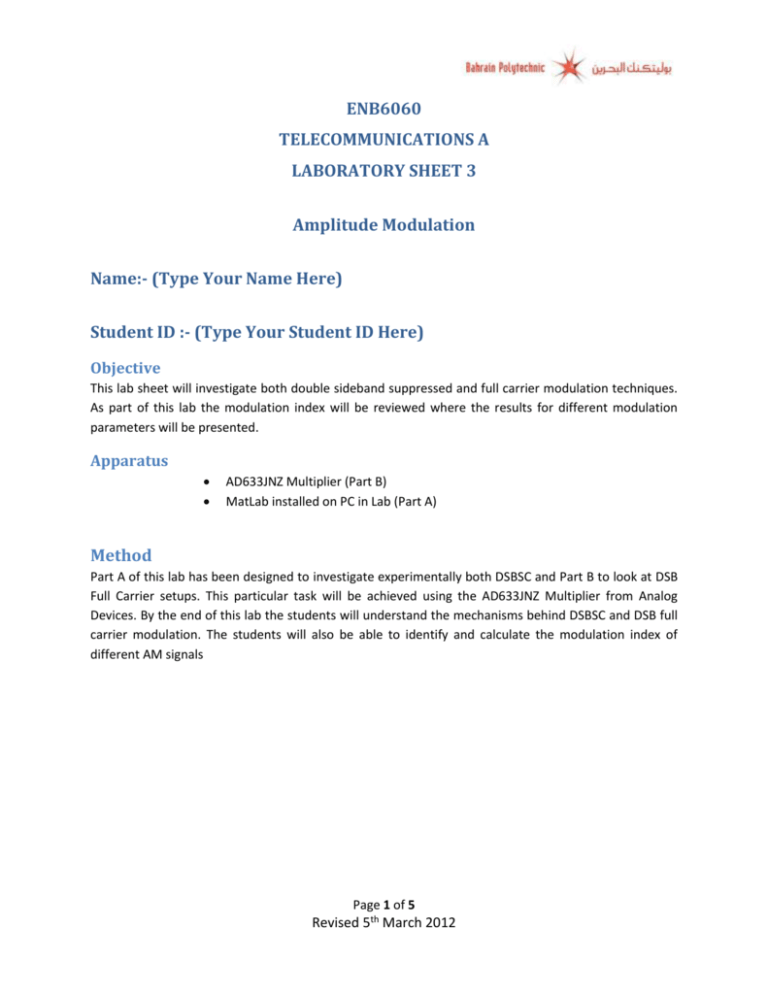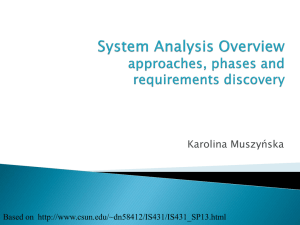Lab3
advertisement

ENB6060 TELECOMMUNICATIONS A LABORATORY SHEET 3 Amplitude Modulation Name:- (Type Your Name Here) Student ID :- (Type Your Student ID Here) Objective This lab sheet will investigate both double sideband suppressed and full carrier modulation techniques. As part of this lab the modulation index will be reviewed where the results for different modulation parameters will be presented. Apparatus AD633JNZ Multiplier (Part B) MatLab installed on PC in Lab (Part A) Method Part A of this lab has been designed to investigate experimentally both DSBSC and Part B to look at DSB Full Carrier setups. This particular task will be achieved using the AD633JNZ Multiplier from Analog Devices. By the end of this lab the students will understand the mechanisms behind DSBSC and DSB full carrier modulation. The students will also be able to identify and calculate the modulation index of different AM signals Page 1 of 5 Revised 5th March 2012 Part A DSBSC The AD633 Analog devices Multiplier chip is set up as shown in Figure 1 (Basic Multiplier Connections). Follow the instructions below to determine the Baseband and Carrier Frequencies: Baseband Frequency = The Last Digit of your ID multiplied by 100 (see example below) Carrier Frequency = Baseband signal Frequency multiplied by 10 (see example below) Baseband Amplitude = 3 V Carrier Amplitude = 3 V Frequency Example :- For a student ID = 20900227 the frequency is 7 x 100 = 700 = 700Hz, in this case the frequency of the carrier signal is going to be 700 x 10 = 7000 = 7 KHz. If the case arises where the last digit of your ID is 0 then use the second last digit, i.e. for 20900220 use 2. Use The Arbitrary function Generator to Create the baseband signal and the FGEN to create the carrier signal. Deliverable A.1:- Paste in a Screen Shot of the input and output signals obtained. Include a brief Figure title that indicates the frequencies and their amplitudes. Add any additional comments you feel are necessary to describe the signal. Deliverable A.2:- use the Log Button on the Oscilloscope to obtain the data for the output signal. Write a Matlab script file to plot this data. Paste the graph you obtain into this document along with the fully commented Matlab code. (see Figure 2 for an example of imported data from a Log file of the output signal ). Use the Digital Spectrum Analyzer to observe the spectrum of the signal. Deliverable A.3:- Paste in a Screen Shot of the input and output signals obtained using the digital spectrum analyzer, include a brief Figure title with the information you feel is relevant. Add any additional comments you feel are necessary to describe the signal. Deliverable A.4:- Discuss the amplitude of the signals in the spectrum analysis. Are the values obtained what you expected? You may back up your findings using the mathematical equations discussed during class. Page 2 of 5 Revised 5th March 2012 Figure 1 Basic Multiplier Connections Amplitude Modulated Signal 0.1 0.08 0.06 0.04 Amplitude (Volts) 0.02 0 -0.02 -0.04 -0.06 -0.08 -0.1 0 0.002 0.004 0.006 0.008 0.01 0.012 0.014 0.016 0.018 0.02 Time (seconds) Figure 2 Imported data from Log File Deliverable A.5:- Paste a Screen Shot of the output signal obtained. Include a brief Figure title that indicates the frequencies and their amplitudes. Add any additional comments you feel are necessary to describe the signal. Deliverable A.6:- use the Log Button on the Oscilloscope to obtain the data for the output signal. Write a Matlab script file to plot this data. Paste the graph you obtain into this document along with the fully commented Matlab code. (see Figure 2 for an example of imported data from a Log file of the output signal ). Use the Digital Spectrum Analyzer to observe the spectrum of the signal. Deliverable A.7:- Paste in a Screen Shot of the input and output signals obtained using the digital spectrum analyzer, include a brief Figure title with the information you feel is relevant. Add any additional comments you feel are necessary to describe the signal. Deliverable A.8:- Discuss the amplitude of the signals in the spectrum analysis. Are the values obtained what you expected? You may back up your findings using the mathematical equations discussed during class. Page 3 of 5 Revised 5th March 2012 Part B Set up the AD633JNZ as shown in Figure 3 (Linear Amplitude Modulator). For this analysis use a Carrier and baseband signals with the same characteristics of frequency and amplitudes as used in the first part of this lab unless otherwise stated. Figure 3 Linear Amplitude Modulator Deliverable B.1:- Paste a Screen Shot of the output signal obtained. Include a brief Figure title that indicates the frequencies and their amplitudes. Add any additional comments you feel are necessary to describe the signal. Indicate in thise case the modulation index of the output signal. Does this agree with the theoretical calculation? Deliverable B.2:- use the Log Button on the Oscilloscope to obtain the data for the output signal. Write a Matlab script file to plot this data. Paste the graph you obtain into this document along with the fully commented Matlab code. (see Figure 2 for an example of imported data from a Log file of the output signal ). Deliverable B.3:- Paste a Screen Shot of the output signal obtained. For the following situations: Modulation index = 25 % Modulation index = 50 % Modulation index = 75 % Modulation index = 100 % Include a brief Figure title for each result. Provide the amplitude for both the carrier and baseband signal in each case. Add any additional comments you feel are necessary to describe the signal. Does this agree with the theoretical calculation? Use the Digital Spectrum Analyzer to observe the spectrum of the signal. Deliverable B.4:- Paste in a Screen Shot of the input and output signals obtained using the digital spectrum analyzer, include a brief Figure title with the information you feel is relevant. Add any additional comments you feel are necessary to describe the signal. Page 4 of 5 Revised 5th March 2012 Deliverable B.5:- Discuss the amplitude of the signals in the spectrum analysis. Are the values obtained what you expected? You may back up your findings using the mathematical equations discussed during class. Marking Scheme Deliverable A.1 Deliverable A.2 Deliverable A.3 Deliverable A.4 Deliverable A.5 Deliverable A.6 Deliverable A.7 Deliverable A.8 Deliverable B.1 Deliverable B.2 Deliverable B.3 Deliverable B.4 Deliverable B.5 Independent Student Work Marks Assigned 10 10 10 10 10 10 10 10 10 10 10 10 10 10 Note :- The late Penalty is 5 % per day Deliverable date is 22nd of March 2012 on or before 17:00 The final report is to be uploaded on to Moodle Page 5 of 5 Revised 5th March 2012









